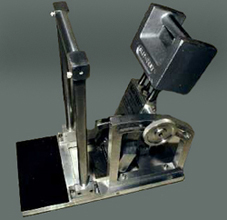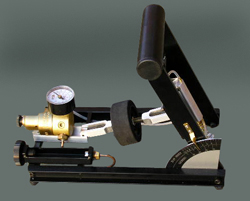Unreliable/Withdrawn Floor Slip Test Methods
ASTM C1028 SCOF test
The ASTM C1028 static coefficient of friction (SCOF) test was withdrawn (with no replacement) by the ASTM in 2014. SCOF testing in the wet condition has shown to have little relevance in predicting slip and fall accidents due to issues such as stiction and the fact that SCOF testing measures how slippery a floor is to someone who is standing still on it – not walking across it. More information on why this test is unreliable (in the wet condition) and was finally withdrawn by the ASTM (never to return) is available at C1028.info. This test was promoted by the American flooring industry because it gave false readings saying that polished, shiny, very slippery floors were not slippery when wet. This helped the American flooring industry sell more slippery tile, which in turn put more innocent people in hospital beds, wheelchairs, and graves. Eventually the fact that this test was total nonsense got around to enough people that the ASTM was forced to withdraw it. The tile Industry then needed another test that said polished, slippery floors aren’t slippery when wet. ANSI A326.3 is that test in 2026, and the first version of that test (ANSI A1371.) with the BOT-3000 (the predecessor of the BOT-3000E) was first published the same year ASTM C1028 was withdrawn – 2014. The American flooring industry wastes no time making personal injury attorneys and surgeons rich at the expense of innocent pedestrians.
The ASTM now has a reliable test method for assessing floor slip potential based on 50 years of international research in 2022’s version of ASTM E303-22 “Standard Test Method for Measuring Surface Frictional Properties Using the British Pendulum Tester”. It is based on similar tests for the pendulum tester in over 50 nations, and over 50 years of international research. The pendulum is known the world over for accuracy and precision in assessing floor safety.

ASTM C1028 SCOF test in progress
Brungraber Mark II and Brungraber Mark IIIB
The now defunct and withdrawn ASTM F1677 used the Brungraber Mark II (also known as PIAST) test device (pictured below). ASTM withdrew this standard in 2006 (ten years after passing this “provisional standard”), with no replacement. The standard was “provisional” because the users of the Brungraber Mark II were not able to produce a “reasonable precision statement” required by the ASTM for officially published standards. After ten years of politely asking the Brungraber Mark II users (who are all now Brungraber Mark IIIB users, presumably) for some sort of evidence that their instrument had precision, the ASTM was forced to withdraw the “provisional” standard for this device only used in American courtroom by unscrupulous slip and fall “liars for hire”. It has no international acceptance and no other country has had any interest in these devices.
The reason for ASTM’s withdrawal was clearly poor precision in interlaboratory studies, meaning that everyone gets a different answer when testing the same tiles using this device. This tester (the Mark II, which looks almost identical to the Mark IIIB) and it’s withdrawn test method are therefore unreliable for assessing pedestrian slip risk. The unscrupulous full-time “expert” witnesses who make their living lying to juries with this device decided to make a couple minor adjustments to the Mark II, and then change its name to the Brungraber Mark IIIB so they could continue to fool juries with “test data” using this unreliable, imprecise device that can be easily manipulated by the user to get whatever answer they are paid to get by a high-powered attorney.
The users of the Brungraber Mark II and their latest toy the Brungraber Mark IIIB have now had 36 years to produce a “reasonable precision statement” for the ASTM, and it still hasn’t been produced. Perhaps the dog ate it? But what has been produced is published data from a peer-reviewed research study showing this device does lack precision. Every user gets a much different reading on the exact same tile. For this reason, and the lack of any peer-reviewed published test method in any nation, should mean these “liars for hire” should not be allowed in any courtroom.

Brungraber Mark II
English XL – VIT
The now withdrawn and defunct ASTM F 1679 used the English XL Variable Incidence Tribometer (VIT), primarily for wet testing (pictured below). ASTM withdrew this standard in 2006 (with no replacement). One reason for this standard being withdrawn was poor precision, which made different users get totally different answers when testing the exact same tiles. Results from this slip tester depend highly on how the button is pressed to initiate the test, and therefore wildly different results can be obtained depending on who is pushing the button. The English XL’s test results can be manipulated by experienced users by pushing the button slowly or quickly, which makes it a popular device amongst professional slip and fall expert witnesses who can get the results the lawyer (paying his bill) wants to see to support his/her case.

English XL – VIT
ASTM D2047
The soon-to-be-withdrawn ASTM D2047 is another SCOF scam that measures how slippery a floor is to a person who is standing still on a clean and dry floor. This isn’t a “safety test” in any way, and anyone promoting it as such is either a liar or a fool. There’s no science or research backing this as a “safety test”, and ASTM D2047 is identical to the UL 410 scam that says any floor that has a SCOF above 0.50 when clean and dry is “safe”. That couldn’t be further from the truth. It’s another scam created by tile, flooring and floor polish manufacturers to create fake data to fool consumers into buying slippery floor products. The people behind these scams are horrible sociopaths, to say the least. If you’ve been horribly injured in a slip and fall incident or lost a loved one, you might want to thank the con artists in ASTM’s D21 committee.
See the slip test devices in action in this video:
Most personal injury lawyers will have on speed-dial expert “liars for hire” who use the Brungraber Mark IIIB and English XL slip testers, and most lawyers who specialize in slip and fall lawsuits will have an older gentleman with a bunch of letters behind his name, a bunch of nice suits in his closet, and hundreds of highly-paid depositions and court testimonies under his belt. These “experts” will just about always get whatever answer their lawyer client desires, whether working for defense or plaintiff. If you’re looking to win a slip and fall lawsuit with little regard for the truth, then these “experts” will serve you well. If you’re an architect, specifier, building owner, flooring designer/manufacturer, or other party who desires the truth based on decades of slip and fall research around the world, you’ll want a pendulum DCOF test using ASTM E303-22, Europe’s BS EN 16165, or Australia’s AS 4586.
ANSI A326.3 with the BOT-3000E
Although the BOT-3000E and it’s test method ANSI A326.3 do have some very limited situations where it can be useful, such as monitoring for changes in slip resistance in a building over time, the ANSI A326.3 test should never be used to assess slip resistance or floor safety.
The ANSI A326.3 floor test method itself says it should not be used for that purpose, and it also says that it lacks precision and will “produce misleading measured DCOF values due to test device constraints” on anything other than flooring that is smooth. But the BOT-3000E also gives misleading values and lacks precision on smooth surfaces, especially polished concrete surfaces. The amount of disclaimers and warnings in ANSI A326.3 leaves the reader thinking he should throw both the test method and the very expensive BOT-3000E in a trash can. The machine gives “passing” DCOF ratings to the most slippery floors on earth at times, and both the test method and the machine are not trustworthy indicators of floor safety. The machine lacks precision and it says so in the quote above from the only test method published for the machine. It does not have international acceptance due to this lack of precision and the myriad of erroneous readings given by this device on too many surfaces.
Many people have been fooled by the manufacturer of the device and representatives of the American flooring industry that ANSI A326.3 with the BOT-3000E can be used as a safety assessment tool, but to do so will be a big mistake. The test method says to not use the test for that purpose, and after a decade or so of getting really high readings on really slippery floors, experts (with integrity) all agree that this test should never be used to assess the slip resistance safety of any flooring. The main purpose of the BOT-3000E seems to be filling the bank accounts of surgeons and personal injury attorneys. To use the BOT-3000E as a safety assessment is simply fraud.
